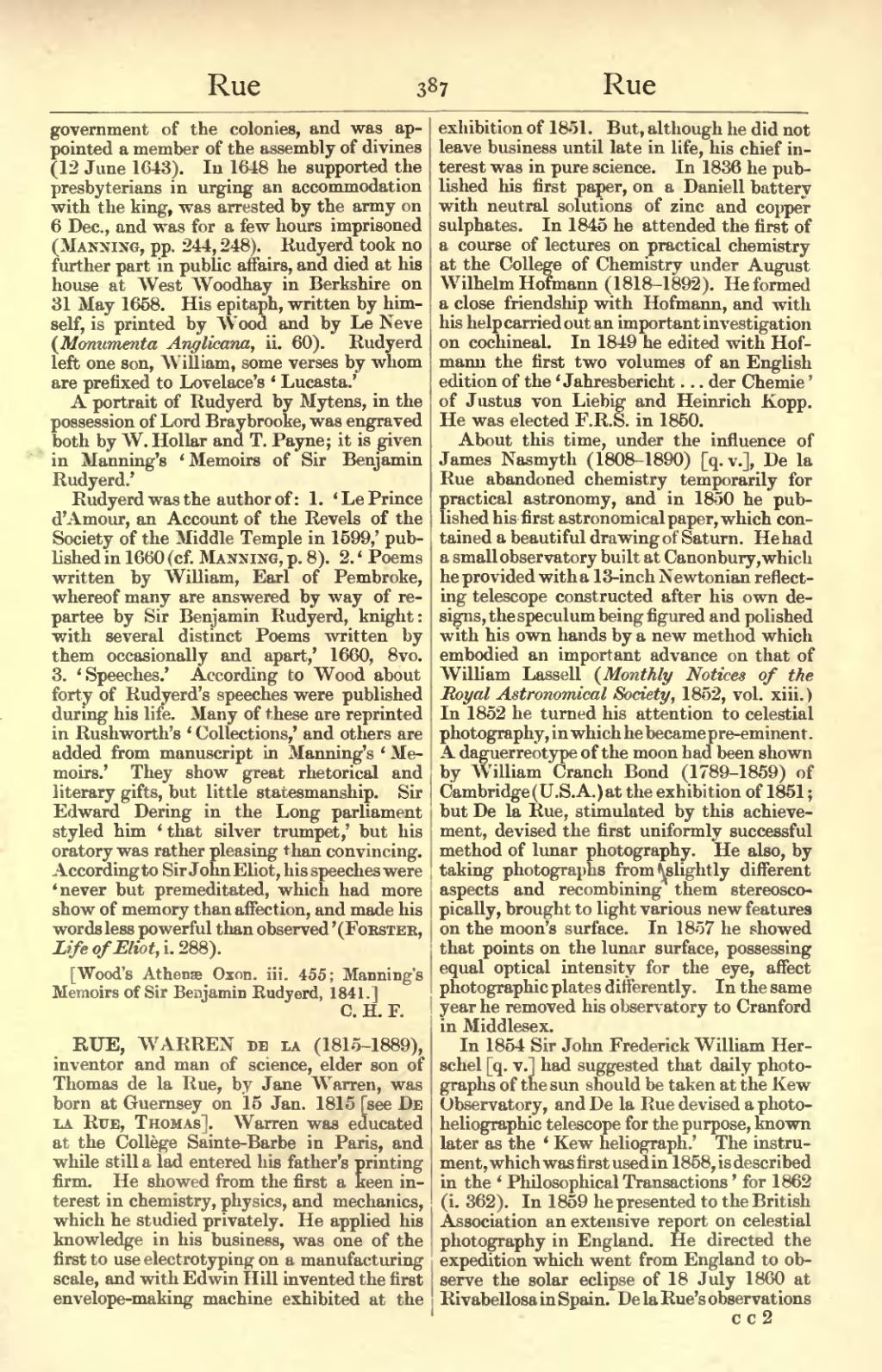government of the colonies, and was appointed a member of the assembly of divines (12 June 1643). In 1648 he supported the presbyterians in urging an accommodation with the king, was arrested by the army on 6 Dec., and was for a few hours imprisoned (Manning, pp. 244, 248). Rudyerd took no further part in public affairs, and died at his house at West Woodhay in Berkshire on 31 May 1658. His epitaph, written by himself, is printed by Wood and by Le Neve (Monumenta Anglicana, ii. 60). Rudyerd left one son, William, some verses by whom are prefixed to Lovelace's ‘Lucasta.’
A portrait of Rudyerd by Mytens, in the possession of Lord Braybrooke, was engraved both by W. Hollar and T. Payne; it is given in Manning's ‘Memoirs of Sir Benjamin Rudyerd.’
Rudyerd was the author of: 1. ‘Le Prince d'Amour, an Account of the Revels of the Society of the Middle Temple in 1599,’ published in 1660 (cf. Manning, p. 8). 2. ‘Poems written by William, Earl of Pembroke, whereof many are answered by way of repartee by Sir Benjamin Rudyerd, knight: with several distinct Poems written by them occasionally and apart,’ 1660, 8vo. 3. ‘Speeches.’ According to Wood about forty of Rudyerd's speeches were published during his life. Many of these are reprinted in Rushworth's ‘Collections,’ and others are added from manuscript in Manning's ‘Memoirs.’ They show great rhetorical and literary gifts, but little statesmanship. Sir Edward Dering in the Long parliament styled him ‘that silver trumpet,’ but his oratory was rather pleasing than convincing. According to Sir John Eliot, his speeches were ‘never but premeditated, which had more show of memory than affection, and made his words less powerful than observed’ (Forster, Life of Eliot, i. 288).
[Wood's Athenæ Oxon. iii. 455; Manning's Memoirs of Sir Benjamin Rudyerd, 1841.]
RUE, WARREN de la (1815–1889), inventor and man of science, elder son of Thomas de la Rue, by Jane Warren, was born at Guernsey on 15 Jan. 1815 [see De La Rue, Thomas]. Warren was educated at the Collège Sainte-Barbe in Paris, and while still a lad entered his father's printing firm. He showed from the first a keen interest in chemistry, physics, and mechanics, which he studied privately. He applied his knowledge in his business, was one of the first to use electrotyping on a manufacturing scale, and with Edwin Hill invented the first envelope-making machine exhibited at the exhibition of 1851. But, although he did not leave business until late in life, his chief interest was in pure science. In 1836 he published his first paper, on a Daniell battery with neutral solutions of zinc and copper sulphates. In 1845 he attended the first of a course of lectures on practical chemistry at the College of Chemistry under August Wilhelm Hofmann (1818–1892). He formed a close friendship with Hofmann, and with his help carried out an important investigation on cochineal. In 1849 he edited with Hofmann the first two volumes of an English edition of the ‘Jahresbericht … der Chemie’ of Justus von Liebig and Heinrich Kopp. He was elected F.R.S. in 1850.
About this time, under the influence of James Nasmyth (1808–1890) [q. v.], De la Rue abandoned chemistry temporarily for practical astronomy, and in 1850 he published his first astronomical paper, which contained a beautiful drawing of Saturn. He had a small observatory built at Canonbury, which he provided with a 13-inch Newtonian reflecting telescope constructed after his own designs, the speculum being figured and polished with his own hands by a new method which embodied an important advance on that of William Lassell (Monthly Notices of the Royal Astronomical Society, 1852, vol. xiii.). In 1852 he turned his attention to celestial photography, in which he became pre-eminent. A daguerreotype of the moon had been shown by William Cranch Bond (1789–1859) of Cambridge (U.S.A.) at the exhibition of 1851; but De la Rue, stimulated by this achievement, devised the first uniformly successful method of lunar photography. He also, by taking photographs from slightly different aspects and recombining them stereoscopically, brought to light various new features on the moon's surface. In 1857 he showed that points on the lunar surface, possessing equal optical intensity for the eye, affect photographic plates differently. In the same year he removed his observatory to Cranford in Middlesex.
In 1854 Sir John Frederick William Herschel [q. v.] had suggested that daily photographs of the sun should be taken at the Kew Observatory, and De la Rue devised a photo-heliographic telescope for the purpose, known later as the ‘Kew heliograph.’ The instrument, which was first used in 1858, is described in the ‘Philosophical Transactions’ for 1862 (i. 362). In 1859 he presented to the British Association an extensive report on celestial photography in England. He directed the expedition which went from England to observe the solar eclipse of 18 July 1860 at Rivabellosa in Spain. De la Rue's observations
